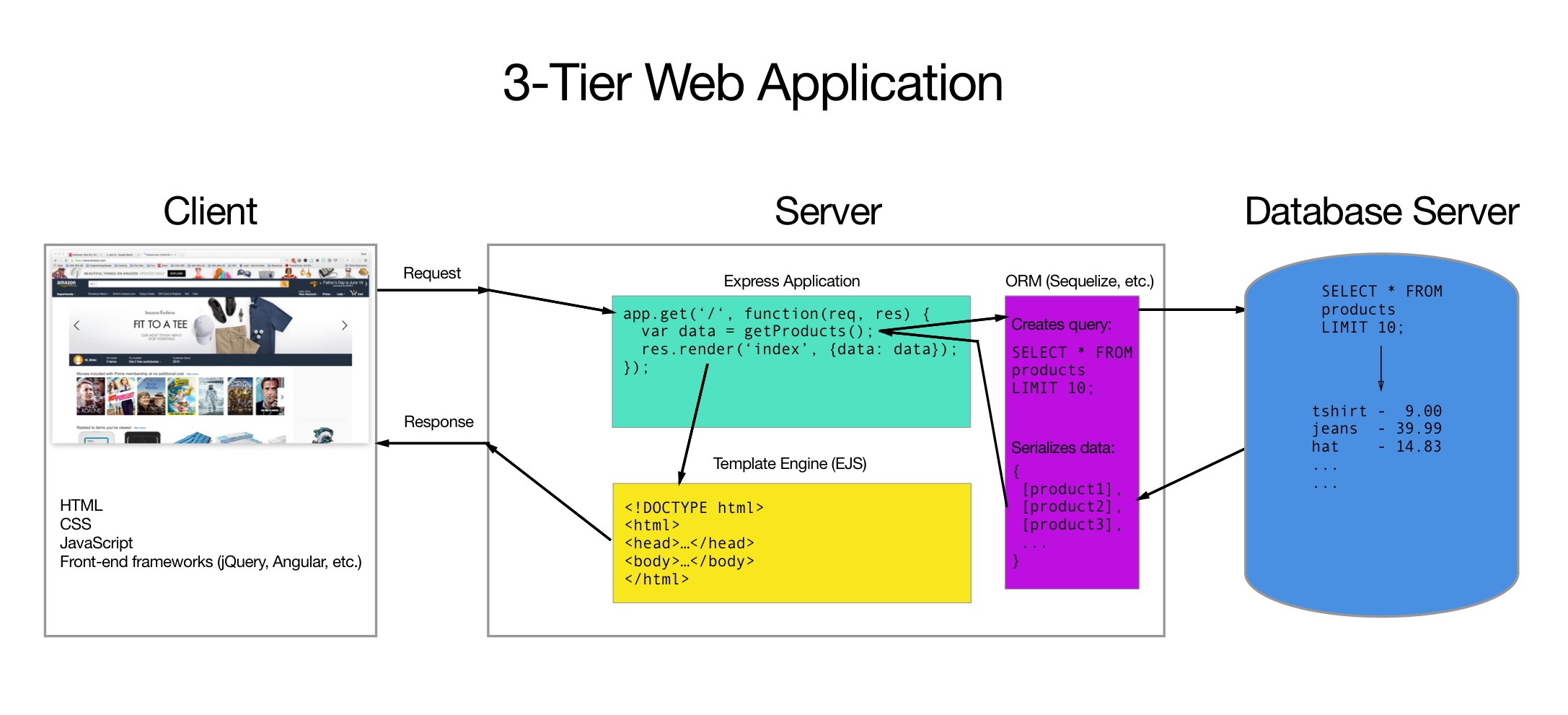CRUD Express SQL
Now we'll integrate our node.js code into an express app.

RESTful Routing
We can also see that each HTTP action maps to a kind of SQL query.
| URL | HTTP Verb | Action | SQL |
|---|---|---|---|
| /photos/ | GET | index | SELECT |
| /photos/new | GET | new | N/A (SELECT) |
| /photos | POST | create | INSERT |
| /photos/:id | GET | show | SELECT |
| /photos/:id/edit | GET | edit | SELECT |
| /photos/:id | PATCH/PUT | update | UPDATE |
| /photos/:id | DELETE | destroy | DELETE |
pg pool
Pool is a functionality oif the pg library that manages connecting with the database when your app may try to connect multiple times.
We will be using the pool bolierplate to make SQL queries.
In your express config (at the top of the file)
const pg = require('pg');
// Initialise postgres client
const config = {
user: 'akira',
host: '127.0.0.1',
database: 'pokemons',
port: 5432,
};
const pool = new pg.Pool(config);
pool.on('error', function (err) {
console.log('idle client error', err.message, err.stack);
});
Call pool.query as a replacement for client.query
const queryString = 'SELECT * from pokemon'
pool.query(queryString, (err, result) => {
if (err) {
console.error('query error:', err.stack);
response.send( 'query error' );
} else {
console.log('query result:', result);
// redirect to home page
response.send( result.rows );
}
});
Pairing Exercise
Note that you don't need to run any of these SQL-related commands from within psql anymore.
create a new dir
mkdir poke-sql
cd into it
cd poke-sql
init npm
npm init
add express
npm install express
add pg
npm install pg
create your db on the terminal:
createdb pokemons -U akira
create a tables.sql
touch tables.sql
CREATE TABLE IF NOT EXISTS pokemon (
id SERIAL PRIMARY KEY,
name TEXT,
img TEXT,
weight TEXT,
number TEXT
);
create a seed.sql
touch seed.sql
Add some seed data into seed.sql:
INSERT INTO pokemon
(name, img, weight, height)
VALUES
('Bulbasaur', 'http://www.serebii.net/pokemongo/pokemon/001.png', '6.9 kg', '0.71 m');
INSERT INTO pokemon
(name, img, weight, height)
VALUES
('Ivysaur', 'http://www.serebii.net/pokemongo/pokemon/002.png', '13.0 kg', '0.99 m');
INSERT INTO pokemon
(name, img, weight, height)
VALUES
('Venusaur', 'http://www.serebii.net/pokemongo/pokemon/003.png', '100.0 kg', '2.01 m');
run the tables.sql and seed.sql on the terminal. (replace DATABSE_NAME and USERNAME with your own)
psql -d DATABASE_NAME -U USERNAME -f tables.sql
psql -d DATABASE_NAME -U USERNAME -f seed.sql
start your app
nodemon index.js
use this express starter code in index.js:
console.log("starting up!!");
const express = require('express');
const pg = require('pg');
// Initialise postgres client
const configs = {
user: 'YOURUSERNAME',
host: '127.0.0.1',
database: 'pokemons',
port: 5432,
};
const pool = new pg.Pool(configs);
pool.on('error', function (err) {
console.log('idle client error', err.message, err.stack);
});
// Init express app
const app = express();
app.use(express.json());
app.use(express.urlencoded({
extended: true
}));
app.get('/hello', (req, res) => {
// query database for all pokemon
// respond with text that lists the names of all the pokemons
res.send('hello');
});
// boilerplate for listening and ending the program
const server = app.listen(3000, () => console.log('~~~ Tuning in to the waves of port 3000 ~~~'));
let onClose = function(){
console.log("closing");
server.close(() => {
console.log('Process terminated');
pool.end( () => console.log('Shut down db connection pool'));
})
};
process.on('SIGTERM', onClose);
process.on('SIGINT', onClose);
test it: http://127.0.0.1/hello
Instructions
Once the code above runs without errors, add a pool.query SELECT statement inside of app.get /hello.
(Copy the pool.query DB code from above into the app.get.
Further
Write the code necessary to do an INSERT.
- write a get route that renders a form
- write a post route that does the insert statement
Further
Create the view files for the / root route.
Further
Create the /pokemon/:id route.